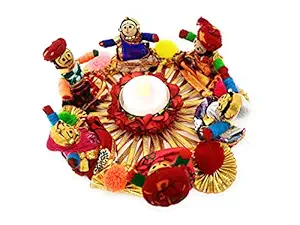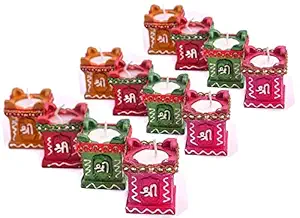बद्रीनाथ मंदिर - भगवान विष्णु का दिव्य निवास
परिचय
3,133 मीटर (10,279 फीट) की ऊंचाई पर गढ़वाल हिमालय में स्थित, उत्तराखंड में बद्रीनाथ मंदिर भगवान विष्णु को समर्पित सबसे प्रतिष्ठित हिंदू तीर्थ स्थलों में से एक है। यह चार धाम यात्रा (बद्रीनाथ, द्वारका, पुरी और रामेश्वरम) और छोटा चार धाम यात्रा (बद्रीनाथ, केदारनाथ, गंगोत्री और यमुनोत्री) का हिस्सा है।
यह मंदिर अलकनंदा नदी के तट पर स्थित है और राजसी नर और नारायण पर्वत श्रृंखलाओं से घिरा हुआ है, जिसमें नीलकंठ शिखर एक आश्चर्यजनक पृष्ठभूमि बनाता है। माना जाता है कि बद्रीनाथ सभी विष्णु मंदिरों में सबसे पवित्र है, जो हर साल लाखों भक्तों को आकर्षित करता है।
बद्रीनाथ मंदिर की पौराणिक कथा
बद्रीनाथ मंदिर का इतिहास हिंदू पौराणिक कथाओं में गहराई से निहित है:
1. भगवान विष्णु का ध्यान
किंवदंतियों के अनुसार, भगवान विष्णु ने ज्ञान प्राप्त करने के लिए बद्रीनाथ में तपस्या की थी। उन्हें गहरी तपस्या में देखकर, देवी लक्ष्मी ने उन्हें कठोर मौसम से बचाने के लिए बद्री वृक्ष का रूप लिया। उनकी भक्ति से प्रसन्न होकर विष्णु ने उस स्थान का नाम बद्रिकाश्रम रखा।
2. नर और नारायण की तपस्या
यह मंदिर विष्णु के जुड़वां अवतार नर और नारायण को समर्पित है, जिन्होंने मानवता के कल्याण के लिए यहां ध्यान किया था।
3. आदि शंकराचार्य का पुनरुद्धार
वर्तमान मंदिर को आठवीं शताब्दी में आदि शंकराचार्य द्वारा पुनः स्थापित किया गया था, जब उन्होंने अलकनंदा नदी में भगवान बद्रीनारायण की काले पत्थर की मूर्ति की खोज की थी। उन्होंने इसे मंदिर में स्थापित किया, जिससे बद्रीनाथ की एक प्रमुख तीर्थस्थल के रूप में शुरुआत हुई।
बद्रीनाथ कैसे पहुंचे
1. हवाई मार्ग से
निकटतम हवाई अड्डा जॉली ग्रांट हवाई अड्डा, देहरादून (311 किमी) है।
देहरादून से बद्रीनाथ के लिए हेलीकाप्टर सेवाएँ उपलब्ध हैं।
2. ट्रेन से
निकटतम रेलवे स्टेशन ऋषिकेश (295 किमी) और हरिद्वार (320 किमी) हैं।
3. सड़क मार्ग से
बद्रीनाथ NH-58 के माध्यम से अच्छी तरह से जुड़ा हुआ है।
हरिद्वार, ऋषिकेश और देहरादून से बसें और टैक्सियाँ उपलब्ध हैं।
बद्रीनाथ से पहले अंतिम प्रमुख पड़ाव जोशीमठ (46 किमी) है।
बद्रीनाथ मंदिर वास्तुकला
बद्रीनाथ मंदिर नागर शैली में निर्मित एक सुंदर 3 मंजिला संरचना है, जिसमें निम्नलिखित विशेषताएं हैं:
सोने की परत चढ़ी छत और जटिल नक्काशी वाली पत्थर की दीवारें।
मुख्य प्रवेश द्वार, जिसे सिंह द्वार के नाम से जाना जाता है, को चमकीले रंगों से रंगा गया है।
गर्भगृह में भगवान बद्रीनारायण की 1 मीटर ऊंची काले पत्थर की मूर्ति है, जो ध्यान मुद्रा में बैठी है।
मंदिर के अंदर
गर्भगृह (आंतरिक गर्भगृह) में भगवान विष्णु, देवी लक्ष्मी, नर और नारायण, गरुड़ और कुबेर (धन के देवता) की मूर्तियाँ हैं।
पुजारी दैनिक पूजा, अभिषेकम और आरती अनुष्ठान करते हैं।
बद्रीनाथ जाने का सबसे अच्छा समय
मंदिर मई से नवंबर तक खुला रहता है और सर्दियों के दौरान भारी बर्फबारी के कारण बंद रहता है।
सर्वोत्तम महीने: मई-जून और सितंबर-अक्टूबर।
मानसून (जुलाई-अगस्त): भूस्खलन की संभावना; जब तक आवश्यक न हो टालें।
शीतकालीन (नवंबर-अप्रैल): मूर्ति को जोशीमठ के नरसिंह मंदिर में ले जाया जाता है।
बद्रीनाथ का आध्यात्मिक महत्व
108 दिव्य देशम (विष्णु के पवित्र मंदिर) में से एक।
चार धाम और छोटा चार धाम यात्रा का हिस्सा।
सबसे पवित्र विष्णु मंदिर माना जाता है जहाँ मोक्ष प्राप्त किया जा सकता है।
आसपास के आकर्षण
1. तप्त कुंड
मंदिर के पास एक प्राकृतिक गर्म पानी का झरना है, जिसके बारे में माना जाता है कि इसमें औषधीय गुण हैं।
मंदिर में प्रवेश करने से पहले भक्त पवित्र स्नान करते हैं।
2. माणा गांव (अंतिम भारतीय गांव)
बद्रीनाथ से 3 किमी दूर भारत-तिब्बत सीमा के पास स्थित है।
व्यास गुफा, गणेश गुफा और भीम पुल जैसे आकर्षणों का घर।
3. चरण पादुका
विष्णु के पैरों के निशान वाली एक चट्टान, मंदिर से 3 किमी ऊपर की ओर स्थित है।
4. वसुधारा जलप्रपात
बद्रीनाथ से 6 किमी दूर एक आश्चर्यजनक 400 फीट का झरना, माना जाता है कि यह पापों को धो देता है।
5. ब्रह्म कपाल
अलकनंदा नदी पर एक पवित्र घाट जहां हिंदू पैतृक संस्कार (पिंड दान) करते हैं।
6. अलकापुरी ग्लेशियर
अलकनंदा नदी का स्रोत माना जाता है, जो बद्रीनाथ से 15 किमी दूर स्थित है।
बद्रीनाथ के प्रमुख त्यौहार
1. बद्री केदार महोत्सव
जून में आयोजित, सांस्कृतिक प्रदर्शन और भक्ति संगीत की प्रस्तुति।
2. माता मूर्ति का मेला
भगवान बद्रीनाथ की माता के सम्मान में सितंबर में मनाया जाता है।
3. समापन समारोह (विजयादशमी)
विजयादशमी पर, मंदिर सर्दियों के लिए बंद हो जाता है, और मूर्ति को जोशीमठ में स्थानांतरित कर दिया जाता है।
तीर्थयात्रियों के लिए यात्रा युक्तियाँ
यात्रा से पहले यात्रा पास के लिए ऑनलाइन पंजीकरण करें।
✅ गर्मी में भी गर्म कपड़े अपने साथ रखें।
✅ पहले से आवास बुक करें, खासकर पीक सीजन के दौरान।
✅ भूस्खलन के कारण मानसून यात्रा से बचें।
✅ शांति से घूमने के लिए सुबह जल्दी यात्रा शुरू करें।
निष्कर्ष
बद्रीनाथ मंदिर की यात्रा सिर्फ एक तीर्थयात्रा नहीं है; यह हिमालय की गोद में एक आध्यात्मिक जागृति है। शांत वातावरण, समृद्ध इतिहास और भगवान विष्णु की दिव्य उपस्थिति इसे एक अविस्मरणीय अनुभव बनाती है।
ॐ नमो भगवते वासुदेवाय 🙏
History of Badrinath Temple
Mythological Origins
Badrinath Temple is believed to have been established by Adi Shankaracharya in the 8th century to revive Hindu dharma.
Scriptural References
The temple is mentioned in ancient texts like the Skanda Purana and Vishnu Purana.
Connection with Lord Vishnu
It is said Lord Vishnu meditated here in the form of Narayana, surrounded by the Badri trees.
Adi Shankaracharya’s Role
Adi Shankaracharya rediscovered the temple and established Badrinath as a key pilgrimage site.
Legends of Nar and Narayan
The twin mountains Nar and Narayan are believed to represent the two forms of Lord Vishnu.
Architecture & Structure
Temple Layout
The temple has a Garbhagriha, Darshan Mandap, and Sabha Mandap with traditional carvings.
Main Idol
The main idol is a 1-meter black stone image of Lord Vishnu seated in Padmasana.
Colorful Façade
The temple features a vibrant façade resembling Buddhist monasteries of the Himalayas.
Hot Springs
The nearby Tapt Kund hot spring is considered holy and used for ritual purification.
Seasonal Opening
The temple opens in April/May and closes in October/November due to heavy snowfall.
Festivals & Rituals
Badrinath Opening Ceremony
The temple opens with grand rituals in April or May, attracting thousands of devotees.
Mata Murti Ka Mela
A major festival celebrating Mata Murti, the mother of Nar and Narayan, is held every September.
Closing Ceremony
The temple closes in late October with special pujas and rituals for winter months.
Daily Worship
Elaborate daily pujas including Shringar Darshan and Shayan Aarti are performed for Lord Vishnu.
Special Yatras
Pilgrims often include Badrinath in the Char Dham and Do Dham Yatras.
Pilgrimage Experience
Char Dham Significance
Badrinath is one of the four sacred Char Dham pilgrimage sites in India.
Spiritual Atmosphere
Surrounded by the Himalayas, the temple offers a divine and serene environment.
Trekking & Accessibility
Pilgrims trek across mountains or travel via roads built for yatris to reach Badrinath.
Nearby Attractions
Mana Village, Vyas Gufa, and Bhim Pul are nearby holy places linked to the Mahabharata.
Foreign Visitors
Many international devotees and spiritual seekers visit Badrinath for its sanctity and heritage.
Cultural & Spiritual Importance
Vishnu Worship
The temple is dedicated to Lord Vishnu, worshipped as Badrinarayan, the preserver of the universe.
Himalayan Heritage
Badrinath represents the deep connection between Hindu spirituality and the Himalayan landscape.
Preservation of Traditions
The temple keeps alive Vedic rituals and traditions practiced for centuries.
Global Recognition
Devotees worldwide recognize Badrinath as one of the most sacred Hindu shrines.
Impact on Local Economy
Pilgrimage tourism supports the economy of Uttarakhand and nearby Himalayan villages.
Badrinath Temple is believed to have been established by Adi Shankaracharya in the 8th century to revive Hindu dharma.
The temple is mentioned in ancient texts like the Skanda Purana and Vishnu Purana.
It is said Lord Vishnu meditated here in the form of Narayana, surrounded by the Badri trees.
Adi Shankaracharya rediscovered the temple and established Badrinath as a key pilgrimage site.
The twin mountains Nar and Narayan are believed to represent the two forms of Lord Vishnu.
The temple has a Garbhagriha, Darshan Mandap, and Sabha Mandap with traditional carvings.
The main idol is a 1-meter black stone image of Lord Vishnu seated in Padmasana.
The temple features a vibrant façade resembling Buddhist monasteries of the Himalayas.
The nearby Tapt Kund hot spring is considered holy and used for ritual purification.
The temple opens in April/May and closes in October/November due to heavy snowfall.
The temple opens with grand rituals in April or May, attracting thousands of devotees.
A major festival celebrating Mata Murti, the mother of Nar and Narayan, is held every September.
The temple closes in late October with special pujas and rituals for winter months.
Elaborate daily pujas including Shringar Darshan and Shayan Aarti are performed for Lord Vishnu.
Pilgrims often include Badrinath in the Char Dham and Do Dham Yatras.
Badrinath is one of the four sacred Char Dham pilgrimage sites in India.
Surrounded by the Himalayas, the temple offers a divine and serene environment.
Pilgrims trek across mountains or travel via roads built for yatris to reach Badrinath.
Mana Village, Vyas Gufa, and Bhim Pul are nearby holy places linked to the Mahabharata.
Many international devotees and spiritual seekers visit Badrinath for its sanctity and heritage.
The temple is dedicated to Lord Vishnu, worshipped as Badrinarayan, the preserver of the universe.
Badrinath represents the deep connection between Hindu spirituality and the Himalayan landscape.
The temple keeps alive Vedic rituals and traditions practiced for centuries.
Devotees worldwide recognize Badrinath as one of the most sacred Hindu shrines.
Pilgrimage tourism supports the economy of Uttarakhand and nearby Himalayan villages.


